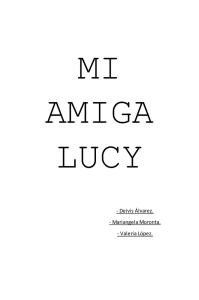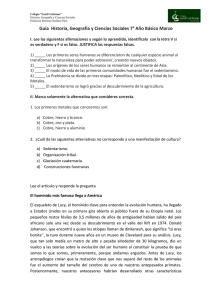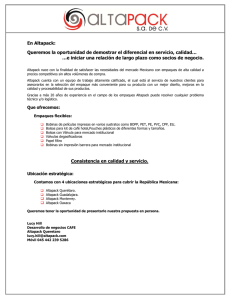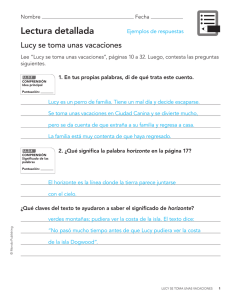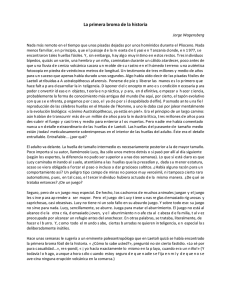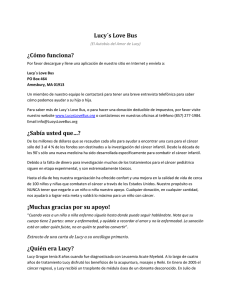EL IRIS DE LUCY
Anuncio
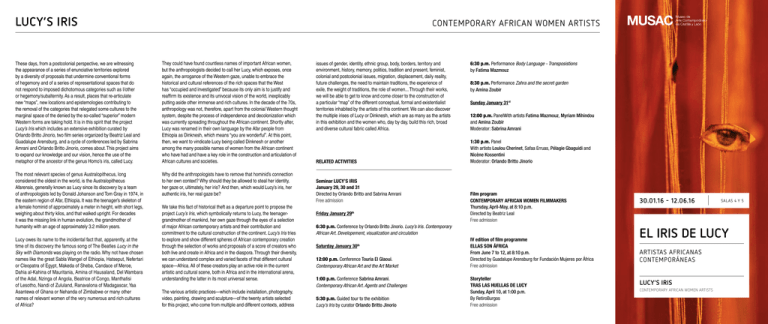
LUCY’S IRIS CONTEMPORARY AFRICAN WOMEN ARTISTS These days, from a postcolonial perspective, we are witnessing the appearance of a series of enunciative territories explored by a diversity of proposals that undermine conventional forms of hegemony and of a series of representational spaces that do not respond to imposed dichotomous categories such as I/other or hegemony/subalternity. As a result, places that re-articulate new “maps”, new locations and epistemologies contributing to the removal of the categories that relegated some cultures to the marginal space of the denied by the so-called “superior” modern Western forms are taking hold. It is in this spirit that the project Lucy’s Iris which includes an extensive exhibition curated by Orlando Britto Jinorio, two film series organized by Beatriz Leal and Guadalupe Arensburg, and a cycle of conferences led by Sabrina Amrani and Orlando Britto Jinorio, comes about. This project aims to expand our knowledge and our vision, hence the use of the metaphor of the ancestor of the genus Homo’s iris, called Lucy. They could have found countless names of important African women, but the anthropologists decided to call her Lucy, which exposes, once again, the arrogance of the Western gaze, unable to embrace the historical and cultural references of the rich spaces that the West has “occupied and investigated” because its only aim is to justify and reaffirm its existence and its univocal vision of the world, inexplicably putting aside other immense and rich cultures. In the decade of the 70s, anthropology was not, therefore, apart from the colonial Western thought system, despite the process of independence and decolonization which was currently spreading throughout the African continent. Shortly after, Lucy was renamed in their own language by the Afar people from Ethiopia as Dinknesh, which means “you are wonderful”. At this point, then, we want to vindicate Lucy being called Dinknesh or another among the many possible names of women from the African continent who have had and have a key role in the construction and articulation of African cultures and societies. The most relevant species of genus Australopithecus, long considered the oldest in the world, is the Australopithecus Afarensis, generally known as Lucy since its discovery by a team of anthropologists led by Donald Johanson and Tom Gray in 1974, in the eastern region of Afar, Ethiopia. It was the teenager’s skeleton of a female hominid of approximately a meter in height, with short legs, weighing about thirty kilos, and that walked upright. For decades it was the missing link in human evolution, the grandmother of humanity with an age of approximately 3.2 million years. Why did the anthropologists have to remove that hominid’s connection to her own context? Why should they be allowed to steal her identity, her gaze or, ultimately, her iris? And then, which would Lucy’s iris, her authentic iris, her real gaze be? Lucy owes its name to the incidental fact that, apparently, at the time of its discovery the famous song of The Beatles Lucy in the Sky with Diamonds was playing on the radio. Why not have chosen names like the great Sabla Wangel of Ethiopia, Hatseput, Nefertari or Cleopatra of Egypt, Makeda of Sheba, Candace of Meroe, Dahia al-Kahina of Mauritania, Amina of Hausaland, Del Wambara of the Adal, Nzinga of Angola, Beatrice of Congo, Manthatisi of Lesotho, Nandi of Zululand, Ranavalona of Madagascar, Yaa Asantewa of Ghana or Nehanda of Zimbabwe or many other names of relevant women of the very numerous and rich cultures of Africa? We take this fact of historical theft as a departure point to propose the project Lucy’s Iris, which symbolically returns to Lucy, the teenagergrandmother of mankind, her own gaze through the eyes of a selection of major African contemporary artists and their contribution and commitment to the cultural construction of the continent. Lucy’s Iris tries to explore and show different spheres of African contemporary creation through the selection of works and proposals of a score of creators who both live and create in Africa and in the diaspora. Through their diversity, we can understand complex and varied facets of that different cultural space—Africa. All of these creators play an active role in the current artistic and cultural scene, both in Africa and in the international arena, understanding the latter in its most universal sense. The various artistic practices—which include installation, photography, video, painting, drawing and sculpture—of the twenty artists selected for this project, who come from multiple and different contexts, address issues of gender, identity, ethnic group, body, borders, territory and environment, history, memory, politics, tradition and present, feminist, colonial and postcolonial issues, migration, displacement, daily reality, future challenges, the need to maintain traditions, the experience of exile, the weight of traditions, the role of women... Through their works, we will be able to get to know and come closer to the construction of a particular “map” of the different conceptual, formal and existentialist territories inhabited by the artists of this continent. We can also discover the multiple irises of Lucy or Dinknesh, which are as many as the artists in this exhibition and the women who, day by day, build this rich, broad and diverse cultural fabric called Africa. RELATED ACTIVITIES Seminar LUCY’S IRIS January 29, 30 and 31 Directed by Orlando Britto and Sabrina Amrani Free admission Friday January 29th 6:30 p.m. Conference by Orlando Britto Jinorio. Lucy’s Iris. Contemporary African Art. Developement, visualization and circulation Saturday January 30th 12:00 p.m. Conference Touria El Glaoui. Contemporary African Art and the Art Market 1:00 p.m. Conference Sabrina Amrani. Contemporary African Art. Agents and Challenges 5:30 p.m. Guided tour to the exhibition Lucy’s Iris by curator Orlando Britto Jinorio 6:30 p.m. Performance Body Language - Transposistions by Fatima Mazmouz 8:30 p.m. Performance Zahra and the secret garden by Amina Zoubir Sunday January 31st 12:00 p.m. PanelWith artists Fatima Mazmouz, Myriam Mihindou and Amina Zoubir Moderator: Sabrina Amrani 1:30 p.m. Panel With artists Loulou Cherinet, Safaa Erruas, Pélagie Gbaguidi and Nicène Kossentini Moderator: Orlando Britto Jinorio Film program CONTEMPORARY AFRICAN WOMEN FILMMAKERS Thursday, April-May, at 8:10 p.m. Directed by Beatriz Leal Free admission IV edition of film programme ELLAS SON ÁFRICA From June 7 to 12, at 8:10 p.m. Directed by Guadalupe Arensburg for Fundación Mujeres por África Free admission Storyteller TRAS LAS HUELLAS DE LUCY Sunday, April 10, at 1:00 p.m. By RetiroBurgos Free admission 30.01.16 - 12.06.16 SALAS 4 Y 5 EL IRIS DE LUCY ARTISTAS AFRICANAS CONTEMPORÁNEAS LUCY’S IRIS CONTEMPORARY AFRICAN WOMEN ARTISTS EL IRIS DE LUCY Actualmente desde una perspectiva postcolonial se están configurando una serie de territorios enunciativos por los que transitan una diversidad que resquebraja formas convencionales de hegemonía y una serie de espacios representacionales que no responden a categorías dicotómicas impuestas como yo/ otro o hegemonía/subalternidad. Es así como se consolidan lugares que (re)articulan nuevos “mapas”, nuevas localizaciones y epistemologías que contribuyen al desalojo de las categorías que confinaban a algunas culturas al espacio marginal de lo negado por las supuestas “formas superiores” modernas occidentales. Con este ánimo surge el proyecto El iris de Lucy, que incluye una amplia exposición comisariada por Orlando Britto Jinorio, dos programas de cine dirigidos respectivamente por Beatriz Leal y Guadalupe Arensburg, y un ciclo de conferencias dirigido por Sabrina Amrani y Orlando Britto Jinorio. Este proyecto pretende ampliar nuestro conocimiento y nuestra mirada y, por eso, recurre a la metáfora del iris del ancestro del género homo, llamada Lucy. La especie más relevante de homínido australopiteco, considerada durante mucho tiempo la más antigua del mundo, es el Australopithecus Afarensis, conocida normalmente como Lucy desde su descubrimiento por un equipo de antropólogos liderado por Donald Johanson y Tom Gray en 1974, en la región oriental de Afar, en Etiopía. Se trataba del esqueleto adolescente de un homínido femeninio de aproximadamente un metro de estatura y unos treinta kilos de peso, de piernas cortas y que caminaba erguida. Durante décadas se la consideró el eslabón perdido de la evolución humana, la abuela de la humanidad, con una antigüedad aproximada de unos 3,2 millones de años. Lucy debe su nombre a que anecdóticamente, al parecer, en el momento de su descubrimiento sonaba en la radio la famosa canción de los Beatles Lucy in the Sky with Diamonds. ¿Por qué no haber elegido nombres como la gran Sabla Wangel de Etiopía, Hatseput, Nefertari o Cleopatra de Egipto, Makeda de Saba, Candace de Meroe, Kahina de Mauritania, Amina del País Hausa, Del Wambara de Adal, Nzinga de Angola, Beatriz del Congo, Manthatisi de Lesotho, Nandi de Zululandia, Ranavalona de Madagascar, Yaa Ásantewa de Ghana o Nehanda de Zimbabwe ARTISTAS AFRICANAS CONTEMPORÁNEAS u otros muchísimos nombres de mujeres relevantes de las muy numerosas y ricas culturas de África? Podían haber encontrado muchos nombres de importantes mujeres africanas, pero los antropólogos decidieron llamarla Lucy, lo cual desvela, una vez más, la prepotente mirada occidental incapaz de hacer suyos referentes históricos y culturales de los riquísimos espacios que ha “ocupado e investigado” porque tan solo pretende justificar y reafirmar su existencia y visión unívoca del mundo, dejando incomprensiblemente de lado otras inmensas y riquísimas culturas. La antropología no quedaba, pues, en aquellos años setenta al margen del sistema de pensamiento colonial occidental, a pesar de los procesos de independencia y descolonización en todo el continente africano. Lucy fue re-bautizada poco tiempo después por los etíopes de Afar en su propia lengua como Dinknesh, que significa “eres maravillosa”. En este punto reivindicamos pues a Lucy con el nombre de Dinknesh o con otros tantos nombres posibles de mujeres del continente que han tenido y tienen un papel fundamental en la construcción y articulación de las sociedades y las culturas africanas. ¿Por qué los antropólogos tuvieron que sustraerle su conexión con su propio contexto a aquel homínido? ¿Por qué habrían de sustraerle su identidad, su mirada o, en definitiva, su iris? ¿Cuál sería entonces el iris de Lucy, su auténtico iris, su auténtica mirada? Tomamos este hecho de sustracción histórica como punto de partida para proponer el proyecto El iris de Lucy, que de forma simbólica le devuelva a Lucy, a la abuela-adolescente de la humanidad, su propia mirada a través de las miradas de una selección de artistas contemporáneas africanas fundamentales con su aportación y compromiso en la construcción cultural del continente. El iris de Lucy intenta pulsar y mostrar diferentes esferas de la creación contemporánea africana a través de la selección de trabajos y propuestas de una veintena de creadoras que tanto viven y crean en África como en la diáspora. A través de su diversidad podemos entender complejas y variadas facetas de ese diverso espacio cultual que es África. Todas estas creadoras tienen un papel activo en el panorama artístico y cultural actual, tanto en el continente africano como en la escena internacional, entendiendo esta en su sentido más universal. Las diversas prácticas artísticas que incluyen instalación, fotografía, vídeo, pintura, dibujo y escultura de la veintena de artistas seleccionadas para este proyecto, provenientes de múltiples y diversos contextos, abordan cuestiones de género, identidad, etnia, cuerpo, fronteras, territorio y medio ambiente, historia, memoria, política, tradición y presente, cuestiones feministas, coloniales y postcoloniales, migración, desplazamientos, la realidad diaria, los retos de futuro, la necesidad de mantener las tradiciones, la experiencia del exilio, el peso de las tradiciones, el rol de la mujer… A través de sus obras podemos conocer y acercarnos a la construcción de un particular “mapa” de los diferentes territorios existenciales, conceptuales y formales que habitan las artistas de este continente. Podremos igualmente descubrir los múltiples iris de Lucy o Dinknesh, que son tantos como las artistas de esta exposición y como las mujeres que construyen día a día ese rico, amplio y diverso entramado cultural llamado África. ACTIVIDADES PARALELAS SEMINARIO EL IRIS DE LUCY 29, 30 y 31 de enero Dirigido por Orlando Britto Jinorio y Sabrina Amrani Entrada libre y gratuita hasta completar aforo Viernes 29 de enero 18:30 h. Orlando Britto Jinorio El Iris de Lucy. Arte Contemporáneo Africano. Desarrollo, visualización y circulación. Sábado 30 enero 12:00 h. Touria El Glaoui Arte Contemporáneo Africano y mercado del arte 13:00 h. Sabrina Amrani Arte Contemporáneo Africano. Actores y retos 17:30 h. Visita guiada a la exposición El iris de Lucy a cargo del comisario Orlando Britto Jinorio 18:30 h. Lenguaje corporal – transposiciones Performance a cargo de Fatima Mazmouz 20:30 h. Zahra y el jardín secreto Performance a cargo de Amina Zoubir Domingo 31 enero 12:00 h. Mesa redonda Con la participación de las artistas Fatima Mazmouz, Myriam Mihindou y Amina Zoubir Moderada por Sabrina Amrani 13:30 h. Mesa redonda Con la participación de las artistas Loulou Cherinet, Safaa Erruas, Pélagie Gbaguidi y Nicène Kossentini Moderada por Orlando Britto Jinorio Comisariado / Curatorship: Orlando Britto Jinorio Coordinación / Coordination: Carlos Ordás Sala / Halls: 4-5 Artistas / Artists: Jane Alexander, Berry Bickle, Zoulikha Bouabdellah, Loulou Cherinet, Safaa Erruas, Pélagie Gbaguidi, Amal Kenawy, Kapwani Kiwanga, Nicène Kossentini, Mwangi Hutter, Fatima Mazmouz, Julie Mehretu, Myriam Mihindou , Aida Muluneh, Wangechi Mutu, Otobong Nkanga, Tracey Rose, Berni Searle, Sue Williamson, Billie Zangewa, Amina Zoubir Portada / Cover: Safaa Erruas. Invisibles (detalle / detail) 2011. Cortesía de la artista y CulturesInterface Courtesy of the artist and CulturesInterface Exposición co-producida con Exhibition co-produced by Ciclo de cine CINEASTAS AFRICANAS CONTEMPORÁNEAS Jueves de abril y mayo, a las 20:10 h Dirigido por Beatriz Leal Entrada libre y gratuita hasta completar aforo IV Edición del ciclo de cine ELLAS SON ÁFRICA Del 7 al 12 de junio, a las 20:10 h Dirigido por Guadalupe Arensburg para Fundación Mujeres por África Entrada libre y gratuita hasta completar aforo Cuentacuentos TRAS LAS HUELLAS DE LUCY Domingo 10 de abril, a las 13:00 h Por RetiroBurgos Entrada libre y gratuita hasta completar aforo Fechas / Dates: 30 de enero, 2016 -12 de junio de 2016 January 30 to June 12, 2016 www.musac.es Musac. Avda. Reyes Leoneses, 24. 24003, León. T. 987 090 000 Con la colaboración de With the support of
